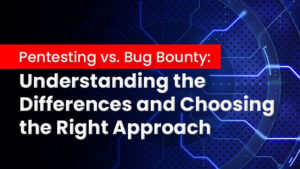Introduction
Understanding your business’s risks, threats, and vulnerabilities is essential for staying compliant and secure. These three elements can be broken down into distinct categories that each require special attention. This article covers detailed knowledge of Threat, Vulnerability, and Risk and their differences.
Asset
It is crucial to understand what an asset is in the area of cyber security in order to differentiate between risk, threat, and vulnerability. Assets include people, things, and knowledge. People refer to both employees and other stakeholders of a company, while property refers to both tangible and intangible assets with some value, and information refers to any kind of relevant data, such as accounts, records, etc. These resources are occasionally subject to threats, risks, and vulnerabilities.
Threat
A threat is a statement or action that suggests a possibility of harm, damage, danger, or negative consequences to a person, group, organization, or entity. It may also refer to an imminent danger or risk that could cause harm or damage. Threats can come from various sources, including individuals, groups, or natural events, and may be intentional or unintentional.
There are three main types of threats:
- Natural threats, such as floods, hurricanes, or tornadoes
- Unintentional threats, like an employee, mistakenly accessing the wrong information
- Intentional threats, such as spyware, malware, or the actions of a disgruntled employee
Vulnerability
A known flaw in a resource (asset) that one or more attackers can use is a vulnerability. In other words, the problem that makes an assault possible is well-known.
For example, if a team member departs and you neglect to remove their names off company credit cards, change logins, or disable access to external accounts, your firm is vulnerable to both purposeful and unintentional risks. However, rather than a person typing on the network’s other side, most vulnerabilities are exploited by automated attackers.
To maintain the security of your systems, vulnerability testing is essential. You can create a plan for an immediate response by determining weak places.
Types of Vulnerability
Based on several factors, vulnerabilities take many different forms. Among them are:
- Network- Network vulnerability is caused by network hardware or software flaws.
- Operating system- When an operating system is created with a policy granting every program and full user access to the computer, viruses, and malware can make modifications on the administrator’s behalf.
- Human- Users’ negligence can cause vulnerabilities in the system.
- Process- Specific process control can also cause vulnerabilities in the system.
Risk
Risk is the potential for harm, loss, or negative consequences resulting from an action or decision. It is the probability or likelihood that a particular event or situation will occur and the extent of the harm or damage it could cause. Risks can arise from a variety of factors, including uncertainty, complexity, variability, or vulnerability, and can affect individuals, organizations, or society as a whole. Managing risks involves identifying, assessing, mitigating, or avoiding potentially negative outcomes.
When creating risk management methods, the following are some important considerations:
Organizations must address breaches and hazards in accordance with their importance and urgency. Numerous system vulnerabilities might not be easily exploited and so do not pose a larger risk. So, depending on the danger, vulnerabilities should be patched.
Organizations should be aware of and estimate their levels of risk tolerance. When implementing a risk management system, the ability to bear risk should be assessed on a regular basis.
-
Knowledge of Vulnerability
Threats will always exist, but the likelihood of risk is minimal or nonexistent if there are no vulnerabilities. In order to identify potential threats to assets, it is crucial to be aware of common vulnerabilities and to monitor those regularly.
Risk = Asset + Threat + Vulnerability
Types of Risks
There are two types of cyber risks, which are as follows:
External cyber threats include cyberattacks, phishing scams, ransomware, DDoS assaults, etc., that originate from outside a business.
Insiders pose a risk to internal cybersecurity. These insiders might be untrained or harbor malicious intentions.

Risk, Threat, and Vulnerability
Every company faces risks, threats, and vulnerabilities. Any threat to a weak asset that jeopardizes achieving corporate goals is considered a risk in the business world. Risks can be internal to the company or external. Risk can take many different forms. Examples of risks include those related to business, finances, operations, technology, security, compliance, availability, and strategy, among many more. But there is one thing that all of these risks have in common. They are all caused by threats and weaknesses.
Any situation that risks an asset qualifies as a threat to business. Threats, then, are everything that has the potential to harm a valuable. “vulnerability” refers to a firm’s shortcomings that make it open to threats.
Due to how they all interact, risks, threats, and vulnerabilities are extremely similar. They all signify very different things, though. A company may be vulnerable without the asset being in danger. If this is the case, there is no danger associated with the vulnerability for the company. On the other hand, a company might face a threat, but the company has strong safeguards to ensure they are not exposed to them. There is no risk associated with the threat if this circumstance exists.
| Threat |
Vulnerability |
Risks |
|
Take advantage of system flaws and have the ability to steal and corrupt data. |
Known as a flaw in hardware, software, or designs that could make it possible for cyber threats to occur. |
Cyber attacks can result in the loss or destruction of data. |
| Generally impossible to control |
Can be managed. |
Can be controlled. |
| It might or might not be done on purpose. |
Generally, unintentional. |
Always intentional |
| By controlling the vulnerabilities, be stopped. |
Identification of the issues, classification, prioritization, and resolution of the vulnerabilities follow in the process of vulnerability management. |
The likelihood of cyber hazards can be reduced by limiting data transfers, getting files from reputable sources, updating the software frequently, engaging a professional cybersecurity team to monitor data, designing an incident management strategy, etc. |
| Can be found in threat detection logs and antivirus software. |
Can be found using devices for penetration testing and numerous vulnerability scanners. |
Can be discovered by looking for enigmatic emails, suspicious pop-up windows, weird password behavior, a slower-than-usual network, etc. |
Conclusion
Keeping up with risk assessments, threats, and vulnerabilities is essential for keeping your business secure and compliant with industry standards and regulations. Regularly assessing risks helps ensure that any issues are identified promptly so they can be addressed before they become larger problems impacting operations or resources negatively.
Additionally, staying alert for potential threats while understanding where weaknesses exist within systems will help keep data safe from malicious actors looking to exploit those weaknesses for their own gain or the gain of others’ data. With this knowledge, businesses can confidently navigate digital landscapes knowing their data is safe from those who wish it harm.








